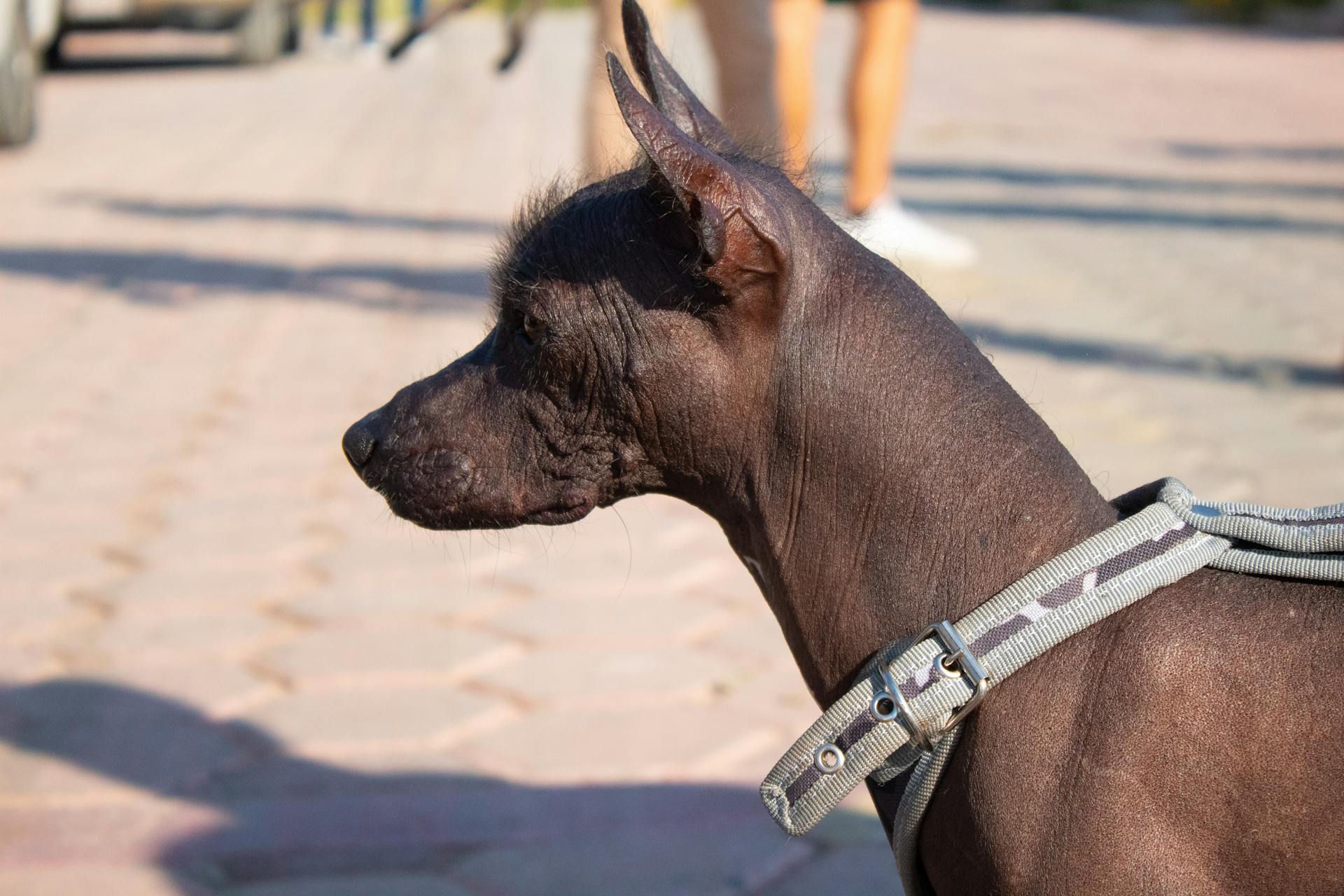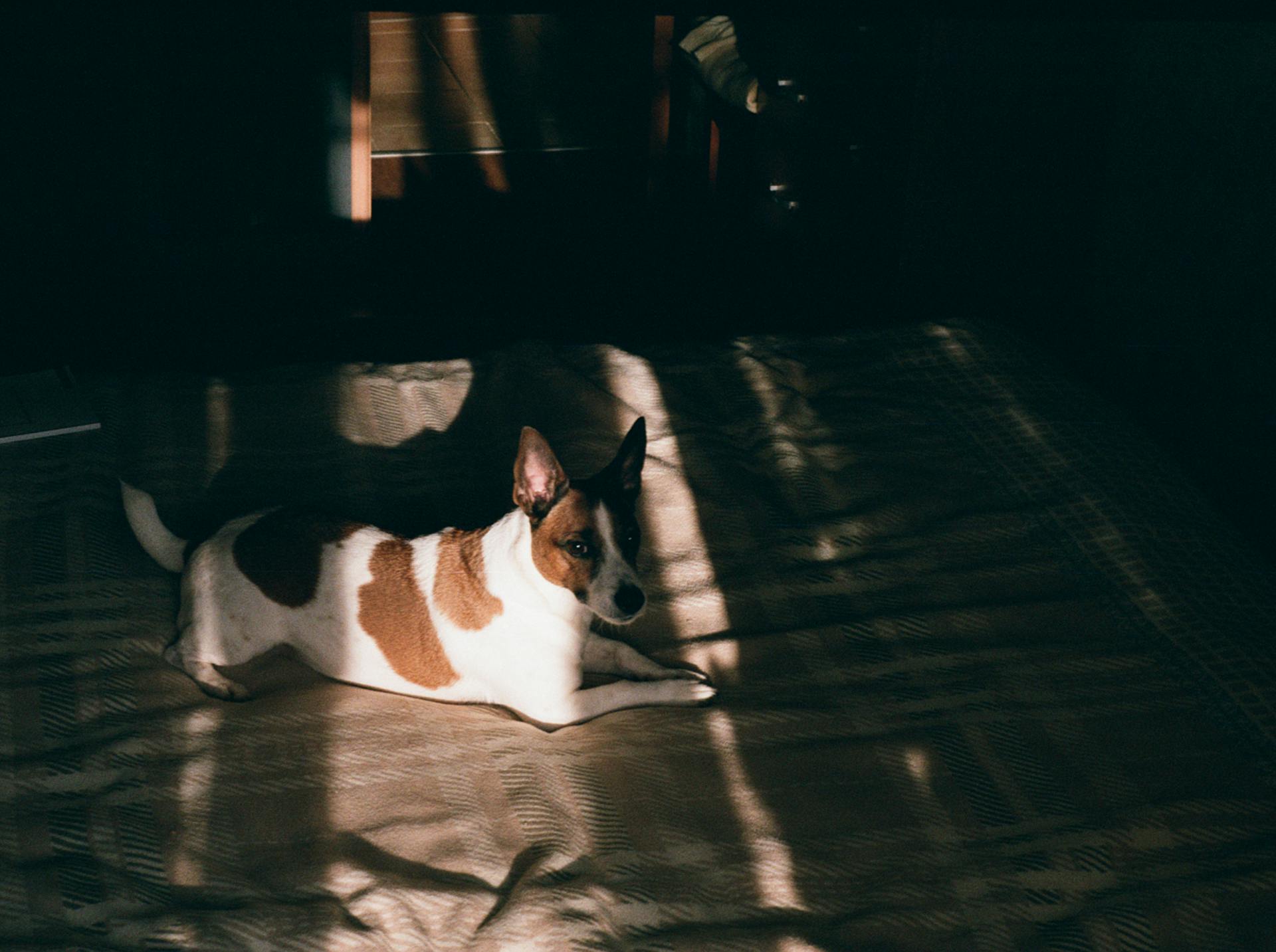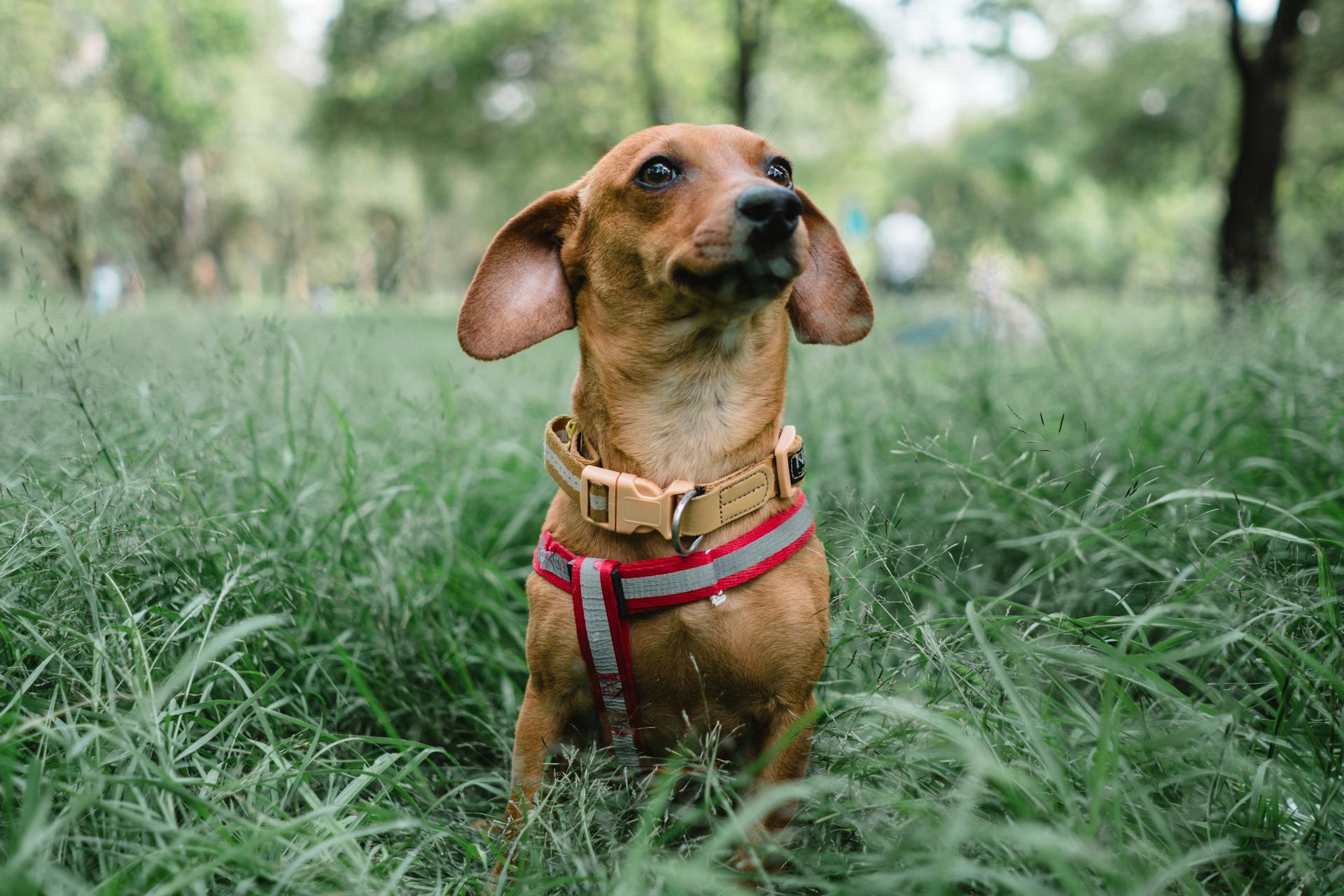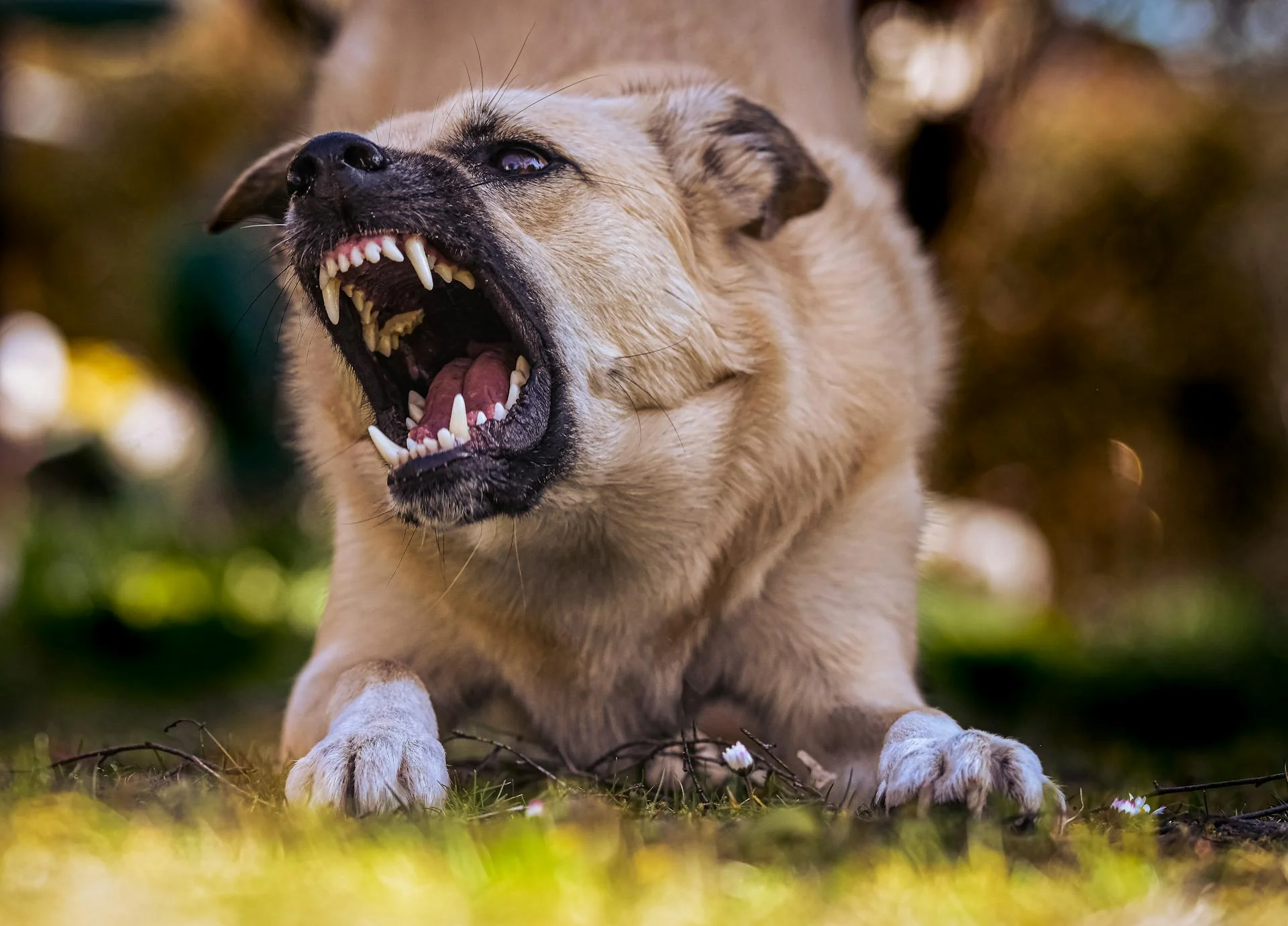
Dog to dog aggression can be a challenging issue for many pet owners. It's estimated that up to 20% of dogs will exhibit aggression towards other dogs at some point in their lives.
Dogs that are not socialized properly from an early age are more likely to develop dog to dog aggression. This is because they may not learn how to interact with other dogs in a calm and respectful manner.
Some common signs of dog to dog aggression include growling, snapping, and posturing. These behaviors can escalate quickly, so it's essential to recognize the warning signs early on.
In many cases, dog to dog aggression can be managed with proper training and socialization. This may involve working with a professional dog trainer or behaviorist to develop a customized training plan.
Suggestion: Signs of Prey Drive in Dogs
Causes and Prevention
Dogs aren't born aggressive, but rather develop behavior problems due to a lack of socialization, basic obedience training, and negative or frightening experiences. These issues can be prevented by properly socializing your puppy and teaching basic commands through home training or group classes.
Readers also liked: Dog Training Basic Obedience Lesson Plan
To prevent behavior problems, puppies need to be exposed to a variety of people, animals, and situations, and taught basic commands. This will help you successfully communicate with your dog and prevent aggression towards other dogs.
Here are some common causes of dog aggression:
- Lack of socialization
- Lack of basic obedience training
- Negative or frightening experiences
By understanding these causes, you can take steps to prevent dog aggression and create a more harmonious relationship with your furry friend.
What Causes?
Dogs aren't born aggressive, so what causes it? Lack of socialization, lack of basic obedience training, and negative or frightening experiences are common culprits.
Dogs need to be properly socialized and exposed to a variety of people, animals, and situations. This helps them develop essential skills that prevent behavior problems.
Puppies that don't receive proper socialization and training may grow into dogs that are reactive to certain stimuli. Identifying these triggers is crucial in preventing aggression.
Here are some common triggers that can set a dog off:
- Strange people
- Other dogs
- Men with beards
- Children
- Leash reactivity (becoming reactive when on a leash)
- Crowded spaces
- Walking at night
By understanding what causes aggression, we can take steps to prevent it. This includes avoiding triggers and working on a training plan with our dogs.
Preventing Aggression
Early socialization is key to preventing aggression in dogs. Socialization involves deliberately exposing your puppy to friendly dogs, but only if they appear neutral or friendly as well.
Lack of socialization is a major cause of aggression in dogs. Puppies need to be properly socialized and exposed to a variety of people, animals, and situations.
Reward-based training can help reduce the risk of your dog developing aggression toward other dogs. This type of training helps you and your dog communicate effectively, allowing you to guide your dog away from other dogs if needed.
Proper socialization and training can prevent behavior problems, but they need to be maintained as your puppy grows. Dogs that didn't develop these skills when they were young can still benefit from obedience training.
Here are some essential skills to teach your puppy:
- Properly socialize and expose to a variety of people, animals, and situations
- Teach basic commands through home training or group classes so dog owners can successfully communicate with them
By teaching these skills, you can help prevent aggression in your dog and strengthen your bond with them.
Recognizing Aggressive Behavior
Aggressive dogs are usually scared, possessive, or territorial. Their body language can give away their intentions.
Standing stiffly and rigidly is a clear sign of aggression in dogs. It's like they're coiled and ready to spring into action.
Growling is another unmistakable sign of aggression. It's a warning sign that they're not happy about something.
Baring their teeth is a common sign of aggression in dogs. It's a threat display, warning others to back off.
Snarling is a low, guttural sound that's often accompanied by a raised hackles and bared teeth. It's a clear indication of aggression.
Dogs may also lunge at someone without making physical contact, which can be a startling and intimidating experience. It's essential to recognize this behavior as a warning sign.
Intentionally pushing against a person with their muzzle is another aggressive behavior. It's a way of asserting dominance or control.
Snapping and nipping are also common signs of aggression in dogs. They may do this as a warning sign or as a way of testing boundaries.
Here's a summary of aggressive behaviors in dogs:
- Standing stiffly and rigidly
- Growling
- Baring their teeth
- Snarling
- Lunging at someone without making physical contact
- Intentionally pushing against a person with their muzzle
- Snapping
- Nipping
Types and Capabilities
Dog to dog aggression is a complex issue, and understanding the different types of aggression is key to addressing it. Fear is a very common reason for aggression, often caused by poor socialization or lack of socialization.
Fear-based aggression can manifest in various ways, such as reacting when backed into a corner or becoming possessive of areas where they spend a lot of time. Poor socialization can also lead to aggression towards dogs that seem to pose zero threat or smaller individuals.
Here are some common types of aggression and their causes:
Understanding the root cause of aggression is crucial in addressing it effectively.
Types of
Fear is a very common reason for aggression in dogs, often caused by poor socialization or lack of socialization. They may react when backed into a corner, or when people do something unpredictable.
Some dogs are aggressive when guarding food, toys, crates, and places they like to spend a lot of time, such as a couch or bed. This type of guarding behavior can develop instinctually among puppies if they grew up having to compete with others in their litter for food.
You might like: Dog Training for Socialization
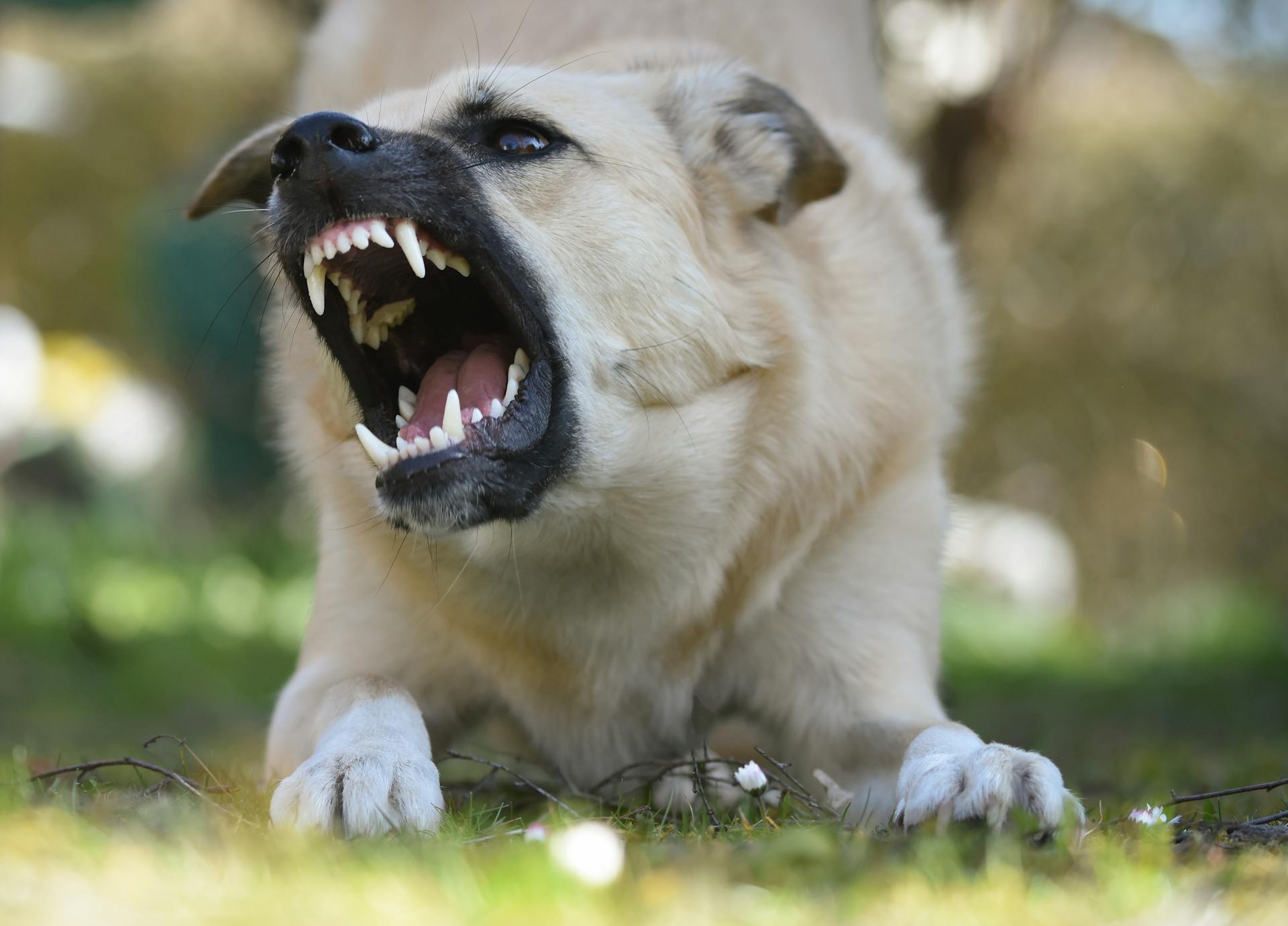
Prey aggression is common in dogs, often caused by instincts and lack of mental stimulation. They may fixate on animals (usually small), become very still when fixating, and may even drool when fixating.
Territorial aggression is also common, often caused by instincts, long periods of time in one area, and lack of mental stimulation. Dogs may become possessive of areas where they spend a lot of time.
Here are some common types of aggression in dogs:
Predatory Behavior
Predatory behavior in dogs can be a serious issue, and it's essential to understand its risks. Dogs exhibiting predatory aggression or behavior towards other dogs can cause grave injury.
It's crucial to keep your dog on a leash when other dogs, particularly small dogs, are nearby for safety. An attack can occur quickly should a small dog suddenly appear.
Treatment for predatory aggression may include using response substitution to teach an alternative behavior, such as 'lie down'. However, aggressive behavior can never be entirely eliminated, meaning there is always some risk that the behavior will resurface.
You might enjoy: Small Dog Aggression
Treatment and Training
Treatment for dog-to-dog aggression can be challenging, but it's not impossible. Sometimes, a particular resource is so valuable to a dog that any approach by another dog can trigger an aggressive response.
Removing valuables before allowing dogs to interact can be a good starting point. However, this may not be enough to address the underlying issue.
Treatment for predatory aggression or behavior toward other dogs may involve using response substitution to teach an alternative behavior, such as 'lie down'. However, aggressive behavior can never be entirely eliminated, meaning there is always some risk that the behavior will resurface.
Punishment-based strategies can actually contribute to an increased intensity of aggression and should be avoided. Instead, consider using positive reinforcement techniques, such as counter-conditioning, to help your dog associate triggers with something positive.
Counter-conditioning involves rewarding your dog with treats, toys, or praise as soon as the trigger appears. This can help your dog associate the trigger with something positive and reduce their stress levels.
If this caught your attention, see: Operant vs Classical Conditioning Dog Training
Treating Predatory Behavior
Predatory aggression or behavior can be treated, but it requires careful management and a solid treatment plan. An attack can occur quickly if a small dog suddenly appears, so it's essential to keep your dog on a leash when other dogs are nearby.
Treatment might include response substitution to teach an alternative behavior like 'lie down', but aggressive behavior can never be entirely eliminated, so there's always some risk that the behavior will resurface. This means you need to be vigilant and consistent with your training.
Dogs exhibiting predatory aggression or behavior towards other dogs can cause grave injury, so it's crucial to address the issue as soon as possible. Unchecked behavior can become progressively worse, making it more challenging to treat.
If you're struggling with your dog's predatory behavior, consult a professional dog trainer or a veterinary behaviorist for guidance. They can help you identify the root of the problem and develop a treatment program that suits your dog's needs.
Medication can be added to the treatment program if your dog has been diagnosed with anxiety, hyperreactivity, or frustration intolerance. However, medication alone is not enough, and behavior modification is always required.
For your interest: Heartworm Treatment Make
Treating Resource Guarding
Treating Resource Guarding can be a challenging task, but it's not impossible. It's essential to understand that some dogs are aggressive when guarding food, toys, crates, and places they like to spend a lot of time.
Consulting with a dog trainer is crucial if your dog tends to growl, snap, or bite when guarding possessions. This is especially important if you have children who may be unable to sense warning signs.
Removing valuables before allowing dogs to interact can be a temporary solution to prevent resource guarding. This can give you time to work on your dog's behavior.
Treating resource guarding requires your dog to learn to accept relinquishing valuables, which can be difficult.
Help Through Our Training
If your dog is exhibiting aggressive behavior, consult professional dog trainers as soon as possible. Unchecked behavior can become progressively worse.
Punishment-based strategies can actually contribute to an increased intensity of aggression and should be avoided.
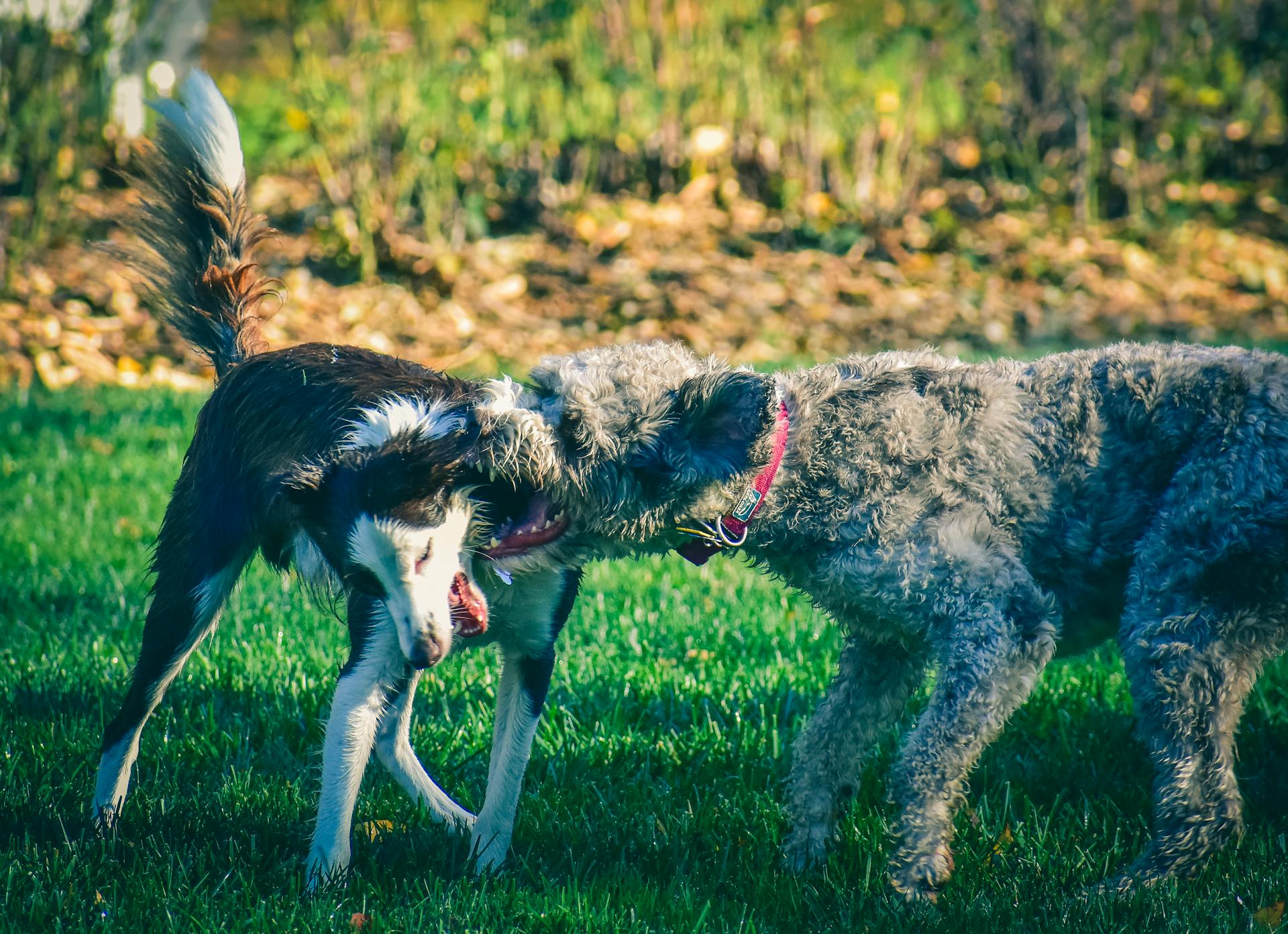
You can help your dog learn to accept relinquishing valuables by removing them before allowing dogs to interact. This can be a challenging task, but it's essential for successful treatment.
Response substitution can be an effective treatment for predatory aggression or behavior, teaching an alternative behavior such as "lie down". However, aggressive behavior can never be entirely eliminated, and there's always some risk that it will resurface.
To reduce aggression, boost your dog's confidence, and establish a strong bond, consider enlisting the help of a professional dog trainer. A customized treatment program can help you and your dog achieve rewarding companionship.
Consistency and frequent training are key to counter-conditioning your dog and making triggers less scary. Start by rewarding your dog with treats as soon as the trigger appears, and gradually increase proximity to the stimulus.
Curious to learn more? Check out: Does Cbd Help with Dog Aggression
Frequently Asked Questions
How to get an aggressive dog to accept a new dog?
Gradually introduce the dogs with short, controlled interactions, followed by separate activities to prevent tension and aggression. This step-by-step approach can help a new dog be accepted by an aggressive dog
Sources
- https://www.ddfl.org/resources/understanding-aggressive-behavior-in-dogs/
- https://vcahospitals.com/know-your-pet/dog-behavior-problems---aggression---unfamiliar-dogs---treatment
- https://www.borntoleadk9.com/dog-training-articles/aggression-in-dogs
- https://www.vet.cornell.edu/departments-centers-and-institutes/riney-canine-health-center/canine-health-information/managing-reactive-behavior
- https://thedogwizard.com/problems/aggression-rehab/
Featured Images: pexels.com
